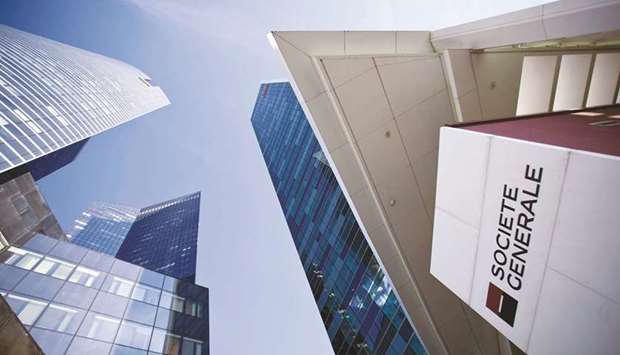Societe Generale SA gave an upbeat outlook for the year as the economic recovery allows it to set aside less for soured loans and a rebound in equities trading fuelled earnings that beat analysts’ estimates.
The Paris-based lender expects to set aside 10 basis points less – equal to about €500mn ($593mn) – for souring debt than it had planned. It also predicted business will increase in all units, after revenue and net income for the bank as a whole blew past analysts’ estimates in the second quarter. SocGen hadn’t previously given such a detailed revenue outlook.
The results so far this year “are the best for five years, illustrating the strength of the business model and the group’s capacity to rebound,” chief executive officer Frederic Oudea said in a statement on Tuesday. “On these bases, the group is raising its full-year forecasts.”
Shares of the lender rose the most in seven months, giving a boost to Oudea, who has vowed to refocus the lender on corporate and transaction banking after steep losses from equity derivatives last year. But underscoring the challenges that remain, the French firm, along with German rival Deutsche Bank AG, was among the weakest of the large banks in European Union stress tests last week that regulators will consult in assessing lenders’ ability to pay dividends.
SocGen’s results mirror the performance of local rival BNP Paribas SA, which last week reported a boost from lower provisions and a recovery in equities trading, though revenue from advising on deals and capital raisings fell in a generally strong quarter for that business.
At SocGen, the advisory business helped drive earnings, with a 9.6% increase. The lender’s advisory unit is seeing “a willingness by big corporates to use their cash amounts on their balance sheets to complete some strategic acquisitions”, head of finance William Kadouch-Chassaing said in an interview on Bloomberg TV.
On the financing side, there’s “a very strong pipeline” in areas such as energy, renewables, infrastructure, asset-backed finance.
Equities trading rebounded from last year’s meltdown, with revenue of €758mn that topped analysts’ highest estimate. Fixed-income trading fell 33%, still better than the 43% drop at the biggest Wall Street banks and at BNP. “What we expect is a less buoyant year than 2020, which was a very brilliant year” for fixed income, said Kadouch-Chassaing, who is also deputy general manager.
Bad loan provisions fell 89%, and the bank said it lowered its full-year estimate for what it calls the cost of risk “in a still uncertain environment but with an improving economic outlook.”
SocGen rose 7.1% in Paris trading, the most since early January. Signs that the business is rebounding have made the stock one of the best performers among peers in Europe this year.
In addition to the trading losses, the bank was also hit last year by the de facto dividend ban imposed through the European Central Bank.
The ECB has since allowed some payouts and is set to lift its cap entirely in September. SocGen resumed shareholder payouts this year and has said it may be able to boost dividends when it has enough clarity on the regulatory framework and the outlook for the economy. The lender currently has a payout ratio of 50% of underlying net income including share buybacks.
The bank, which had announced a €470mn share buyback for the second half of the year, will complete that pending administrative authorisation by the ECB, Kadouch-Chassaing said.
“Societe Generale’s near-30% sector outperformance in 2021 looks increasingly justified as bumper 2Q equities – 534% of the 2Q20 level – and a confirmed buyback for 4Q tick key boxes. Revenue growth 17% above cost growth and improved guidance for cost of risk – a sector-wide theme – were other positives with weak FX and credit trading a mild disappointment,” says Jonathan Tyce, BI banking analyst at Bloomberg.
The bank had a CET1 capital ratio, a key measure of capital strength, of 13.4% at the end of June, also better than expected. But the stress tests unveiled last week showed the measure dropping to one of the lowest readings among the large European Union lenders in an adverse scenario assuming a prolonged period of low interest rates.
The tests results are explained by the severity of the scenario, the methodology, as well as the bank’s exposure to market activities, deputy CEO Diony Lebot said on a call.

The Societe Generale SA company headquarters in the La Defense business district in Paris. SocGen gave an upbeat outlook for the year as the economic recovery allows it to set aside less for soured loans and a rebound in equities trading fuelled earnings that beat analysts’ estimates.


